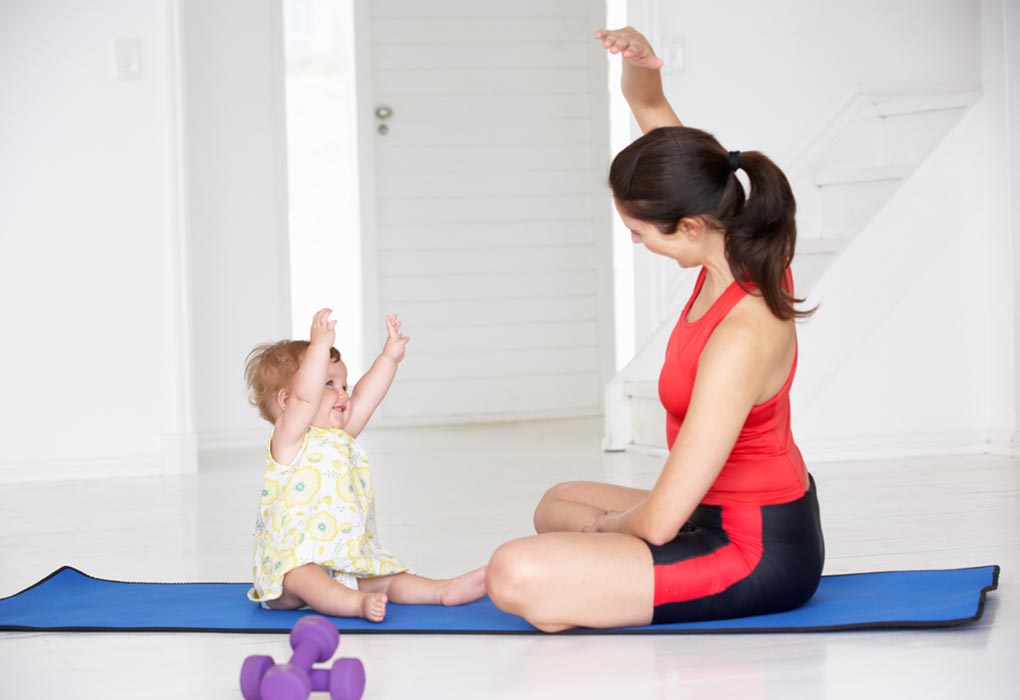You might begin exercising within a few days if you had a straightforward birth without any difficulties.
However, you’ll need to wait until your body recovers if you’ve undergone an episiotomy or a C-section.
Do not start exercising if you have a breast infection, are bleeding profusely, or are still painful from giving birth to your child. A postpartum fitness regimen should also constantly be discussed with your therapist before beginning. Based on your unique situation, your doctor will advise you when it’s safe to begin exercising
Does Exercising Impair Your Ability To Breastfeed?
Exercise does not affect your milk production, despite urban legends and falsehoods to the contrary. Without worrying that exercise could reduce your breast milk production, you are free to work up a sweat as much as you like.
However, specialists from the American College of Obstetricians and Gynecologists advise breastfeeding mothers to make sure they’re drinking enough water beforehand and after working out because being hydrated is so crucial for nursing (ACOG).
Vigorous activity can result in a breast infection and reduce your breast milk production, even if low-to-moderate exercise is safe and healthy. Additionally, it may alter the flavor of your breast milk. Lactic acid can accumulate as a result of strenuous activity and enter breast milk, altering its typically sweet flavor. 4 Sweat can also alter breast milk’s flavor, giving the breasts a salty taste. While some infants are unaffected by these changes, others could object to breastfeeding.
Breastfeed your child or pump right before you go for a run to avoid the uncomfortable feeling of engorgement or weight gain during your workout. Lactic acid concentrations in breast milk might fluctuate after a workout, which can affect the flavor but has no effect on nourishment.
Advantages Of Working Out While Breastfeeding
You likely already know how healthy nursing and exercise are for you, but did you realize how much better they are when done together? A few things that encourage moving include:
More Power
Exercise helps you have more stamina while you’re up late at night nursing, since being a new mom may be demanding.
Mood Improvement
Adequate exercise can help prevent postpartum depression after childbirth. Sadly, according to the Centers for Disease Control and Prevention, PPD affects one in eight mothers (CDC).
Weight Control
In addition to physical activity, breastfeeding burns an extra 300–500 calories each day, which can help with postpartum weight loss.
Establishing A Link With The Baby
When you combine exercise with a happier mood, your ability to bond with your baby is strengthened.
The best workouts for nursing mothers include:
Postnatal yoga, Pilates, and barre swiftly moving
Performing bodyweight exercises like pushups, lunges, planks, and situps while swimming or biking
Weightlifting
Using small weights at first and increasing intensity.
According to ACOG, mothers should strive to complete 150 minutes of moderate aerobic exercise and two sessions of strength training each week.
You might not have as much time or energy for exercise at first when you’re recovering from giving birth and taking care of a newborn. That’s alright. As you get stronger, lengthen the workouts and make them more difficult. Put your general well-being, especially your mental health, first during this hectic and unsettling time.
Uncertain About Where To Start?
Find local exercise clubs to help you resume your exercise routine and meet new parents along the way (a lovely bonus!).
Balancing Breastfeeding And Exercise
It’s challenging to balance obligations when you’re a new parent; the battle is genuine. Even without taking into account housework, outings, or going back to work, breastfeeding may take up a sizable portion of your day.
If adding weekly sessions certainly sounds like too much, start with simple exercises you can do at home while your child is resting, or invest in a decent jogging stroller so she can rest while you work up a sweat.
Every mom requires some “me time.” For the sake of allowing you to go to the gym alone, see if you can leave your kid with your partner, a member of your family, or a babysitter. Some gyms provide kid care! Exercise may be precisely what you need. while being healthy for both you and the baby.
When Not To Work Out While Nursing?
If you experience stomach pain, bleeding, or any fluid leaks, stop exercising and go see your doctor.
Be compassionate with yourself, even if your body is capable of wonderful things (like delivery!). Some new mothers can start exercising right away, but others—particularly those who had C-sections or perhaps more difficult deliveries—may need to wait a little while.
In the first few months following delivery, it’s typical to have diastasis recti, or a thinning and broadening of your abdominal muscles, as well as pelvic floor dysfunction. For advice on the secure pelvic floor and abdominal exercises, speak with your doctor.
What To Wear While Exercising While Nursing?
A nice sports bra is your greatest buddy when it comes to exercising while nursing. Choose a sports bra that is supportive enough to keep you from feeling uncomfortable but isn’t too tight to risk blocking a duct. For the same reason, avoid wearing anything that is excessively tight up top.
Wearing breast pads could be a good idea in case of leaks.
Most importantly, when exercising, dress comfortably and practically. You’ve done a fantastic job of taking care of yourself while raising a baby.
Keeping Exercise-Related Breast Refusal to a Minimum
Beforehand, with a pump or by hand, remove a small amount of breast milk from each breast, then throw it away. Feed your child after that. Additionally, you can breastfeed your child or nurse him or her right before working out. If you choose to do so, it is advised that you wash your breasts or take a shower after working out and before feeding your baby to remove any perspiration. Furthermore, since lactic acid levels can linger in breast milk for up to 90 minutes after a strong activity, wait 90 minutes before actually resuming breastfeeding your child.
Don’t push your child to nurse if they start making faces and show no interest in continuing. If your child is old enough, you can wait a short period before trying again. If you have it, you might also offer your infant a bottle filled with breast milk that you’ve already stored. But don’t delay feeding a small child. Young babies and newborns require meals every two to three hours on average.













